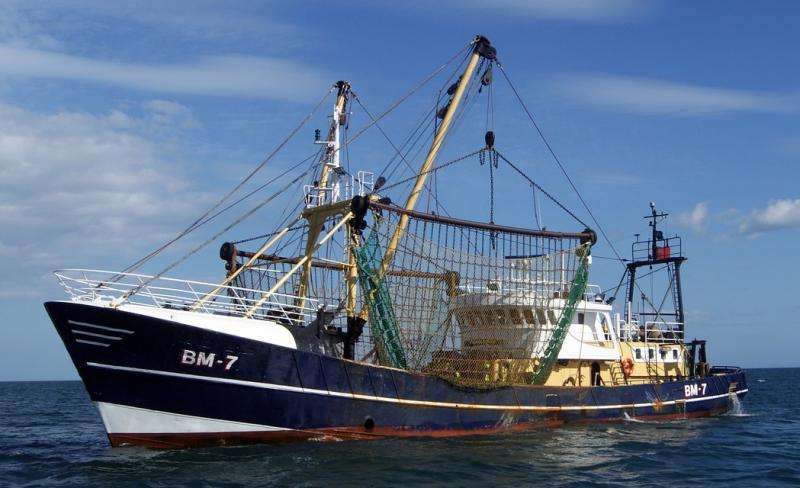Bottom-trawling techniques leave different traces on the seabed

Fishing fleets around the world rely on nets towed along the bottom to capture fish. Roughly one-fifth of the fish eaten globally are caught by this method, known as bottom trawling, which has been criticized for its effects on the marine environment.
An international group has taken a close look at how different types of bottom trawling affect the seabed. It finds that all trawling is not created equal—the most benign type removes 6 percent of the animal and plant life on the seabed each time the net passes, while the most other methods remove closer to a third. A University of Washington professor is among the main authors on the study, led by Bangor University in the U.K. and published July 17 in the Proceedings of the National Academy of Sciences.
The meta-analysis looks at 70 previous studies of bottom trawling, most in the Eastern U.S. and Western Europe. It looks across those studies to compare the effects on the seabed of four techniques: otter trawling, a common method that uses two "doors" towed vertically in the water or along the bottom to hold the net open; beam trawls, which hold the net open with a heavy metal beam; towed dredges, which drag a flat or toothed metal bar directly along the seafloor; and hydraulic dredges, which use water to loosen the seabed and collect animals that live in the sediment.
"We found that otter trawls penetrated the seabed 2.4 cm (0.94 inches) on average and caused the least amount of depletion of marine organisms, removing 6 percent of biota per trawl pass on the seabed," first author Jan Geert Hiddink at Bangor University said in a statement. "In contrast, we found that hydraulic dredges penetrated the seabed 16.1 cm (6.3 inches) on average and caused the greatest depletion, removing 41 percent of the biota per fishing pass."
Depending on the type of fishing gear, penetration depth and environmental variables such as water depth and sediment composition, it took from 1.9 to 6.4 years for the seabed biota, or marine plants and animals, to recover.
"These findings fill an essential science gap that will inform policy and management strategies for sustainable fishing practices by enabling us to evaluate the trade-off between fish production for food, and the environmental cost of different harvesting techniques," said Ray Hilborn, a UW fisheries professor and one of four co-authors who designed the study.
"There's a common perception that you trawl the bottom and the ecosystem is destroyed," Hilborn said. "This study shows that the most common kind of trawling, otter trawling, does not destroy the marine ecosystem, and places that are trawled once a year really won't be very different from places that are not trawled at all."
But the study doesn't let otter trawling completely off the hook.
"We need to view these results in light of the footprint of each of these activities," Hilborn added. "While otter trawling has the least impact per trawl pass, it is the most widely used of all the bottom fishing gear types and hence its effects are more widespread than are those of more specialized fishing gears, such as hydraulic dredges."
The study is one part of a larger effort to catalogue the effects of different types of bottom trawling worldwide, known as the Trawling Best Practices Project, which Hilborn leads with co-authors Michel Kaiser of Bangor University and Simon Jennings of the International Council for the Exploration of the Seas in Denmark. The group is doing other work to estimate how much bottom trawling takes place globally and thus determine the overall effect of bottom disturbance on the seafloor ecosystem. A previously published paper looked at how changes to the seafloor ecosystem affect the populations of fish that people are trying to catch.
Ultimately, the team aims to publish a set of fishing-industry "best practices" for the methods, equipment, density and frequency of bottom trawling.
The authors were unsurprised to find that otter trawling techniques are less destructive than hydraulic dredges. Similar findings came before, including a previous study led by Kaiser, but that one looked at a smaller number of trawling studies. The authors since developed a scrupulous protocol and cast a wide net for the studies included in the current meta-analysis.
"This one is therefore somewhat bulletproof to the criticism that you have been choosing the studies," Hilborn said. "Understanding how gear impacts the bottom, and species on the bottom, is important for a scientific understanding of the impacts of trawling."
More information: Jan Geert Hiddink et al. Global analysis of depletion and recovery of seabed biota after bottom trawling disturbance, Proceedings of the National Academy of Sciences (2017). DOI: 10.1073/pnas.1618858114
Journal information: Proceedings of the National Academy of Sciences
Provided by University of Washington



















